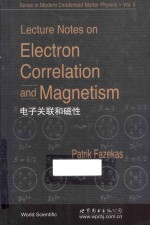图书介绍
电子关联和磁性 英文2025|PDF|Epub|mobi|kindle电子书版本百度云盘下载

- (匈)法则克斯著 著
- 出版社: 上海:世界图书上海出版公司
- ISBN:9787510078644
- 出版时间:2014
- 标注页数:777页
- 文件大小:249MB
- 文件页数:793页
- 主题词:电子相关器-磁性-研究-英文
PDF下载
下载说明
电子关联和磁性 英文PDF格式电子书版下载
下载的文件为RAR压缩包。需要使用解压软件进行解压得到PDF格式图书。建议使用BT下载工具Free Download Manager进行下载,简称FDM(免费,没有广告,支持多平台)。本站资源全部打包为BT种子。所以需要使用专业的BT下载软件进行下载。如BitComet qBittorrent uTorrent等BT下载工具。迅雷目前由于本站不是热门资源。不推荐使用!后期资源热门了。安装了迅雷也可以迅雷进行下载!
(文件页数 要大于 标注页数,上中下等多册电子书除外)
注意:本站所有压缩包均有解压码: 点击下载压缩包解压工具
图书目录
1 Introduction1
1.1 Magnetism and Other Effects of Electron-Electron Inter-action1
1.2 Sources of Magnetic Fields5
1.3 Getting Acquainted:Magnetite7
1.3.1 Charge States8
1.3.2 Spin States9
1.3.3 Charge Ordering11
1.4 Variety of Correlated Systems:An Outline of the Course14
2 Atoms,Ions,and Molecules17
2.1 Hydrogen Atom in a Magnetic Field18
2.1.1 Non-Relativistic Treatment18
Motion in a Magnetic Field19
Zeeman Effect(Ⅰ)21
2.1.2 Relativistic Effects22
Spin-Orbit Coupling24
Zeeman Effect (Ⅱ)25
Problem 2.128
2.2 Direct Exchange28
Problem 2.236
2.3 Many-Electron Ions36
Problem 2.340
2.3.1 Coupling to the Magnetic Field40
Digression:The Bohr-Van Leeuwen Theorem42
2.3.2 Hund's Rules43
Problem 2.445
2.4 Paramagnetism and Diamagnetism45
2.4.1 Paramagnetic Susceptibility46
Magnetization Curve51
Problems 2.5-2.852
2.4.2 Diamagnetism53
Digression:Superstrong Fields54
2.5 Hydrogen Molecule56
2.5.1 Direct Exchange in Non-Orthogonal Orbitals57
2.5.2 Kinetic Exchange60
2.5.3 Molecular Orbitals versus Heitler-London64
Solutions to the Problems66
3 Crystal Field Theory75
3.1 Incomplete Shells in an Anisotropic Environment:Crys-tal Fields75
3.2 The Role of Symmetry Arguments in Quantum Mechanics80
3.2.1 Irreducible Representations82
3.3 The Octahedral Group86
Problems 3.1-3.289
3.4 Symmetry Properties of Atomic States89
3.5 Splitting of a d-Level in Cubic Field91
3.5.1 Quenching the Orbital Angular Momentum94
3.5.2 Partial Restoration of Orbital Momentum by Spin Orbit Coupling96
Problems 3.3-3.498
3.5.3 High-Spin versus Low-Spin States98
3.6 Jahn-Teller Effect100
3.7 Time Reversal Invariance104
3.8 The f2 Configuration110
3.8.1 Cubic Crystal Field111
3.8.2 Tetragonal Crystal Field115
3.8.3 Metamagnetic Transition118
3.8.4 Exchange Induced Magnetism121
Problems 3.5-3.6122
3.9 Double Groups122
Problems 3.7-3.8128
3.10 Crystal Field Potentials128
3.10.1 Quadrupole Moments132
Solutions to the Problems134
4 Mott Transition and Hubbard Model147
4.1 Metals and Insulators:Breakdown of the Independent-Electron Description147
4.2 Mott Transition150
4.3 The Hubbard Model157
4.3.1 Local Basis161
4.3.2 Which Electrons Do We Mean?162
4.4 Limiting Cases163
4.4.1 The Band Limit164
Problems 4.1-4.4166
4.4.2 The Atomic Limit167
What Causes the Ordering?169
4.5 Symmetries170
4.5.1 Spin-Rotational Invariance170
4.5.2 Electron-Hole Symmetry171
Problem 4.5173
4.6 Infinite-Dimensional Hubbard Model173
Problems 4.6-4.8177
4.7 Hubbard Subbands178
4.7.1 The Mott-Hubbard Transition180
4.8 Ground State Phase Diagram182
Solutions to the Problems187
5 Mott Insulators199
5.1 The Large-U Limit199
5.1.1 Classification of Hopping Events200
5.1.2 The Canonical Transformation203
5.1.3 Hubbard Operators205
5.1.4 The t-J Model207
5.1.5 Half-Filled Band:The Heisenberg Model211
Problems 5.1-5.2213
5.1.6 Higher-Order Exchange214
5.2 Superexchange217
5.3 The Extended Hubbard Model221
Problems 5.3-5.5226
5.4 Orbital Degeneracy,Orbital Ordering226
Problems 5.6-5.8234
5.5 Correlated Insulators234
5.5.1 Mott Transitions in Transition Metal Oxides235
5.5.2 Mott Insulators versus Charge Transfer Insulators243
Hole Doping248
Solutions to the Problems250
6 Heisenberg Magnets263
6.1 Ferromagnetic Heisenberg Model264
6.1.1 Ground State:Symmetry Breaking265
6.1.2 Excitations:Spin Waves268
Effects of Anisotropy275
Magnon-Magnon Interactions276
Finite Temperatures277
Problem 6.1279
6.2 Antiferromagnetic Heisenberg Model280
6.2.1 Introduction280
6.2.2 Spin Waves283
Sublattice Magnetization290
Anisotropy297
A Glimpse at the Strange World of D=1299
6.3 Néel Order versus Valence Bond States306
6.3.1 Resonating Valence Bonds307
Problems 6.2-6.4311
Digression:Symmetry Breaking312
6.3.2 Valence Bond Solids315
6.3.3 The CaV4O9 Story326
6.3.4 Frustration330
Problem 6.5335
Solutions to the Problems336
7 Itinerant Electron Magnetism341
7.1 Introduction341
7.2 Magnetic Order344
7.2.1 Digression:Symmetry Breaking347
7.3 Mean Field Theories349
7.4 Stoner Model352
Problems 7.1-7.3357
7.5 Generalized Susceptibility357
7.5.1 Criteria for q≠0 Instabilities360
Problems 7.4-7.5362
7.6 Spin Density Waves363
7.6.1 Gap Equation367
7.6.2 Finite Temperatures370
7.6.3 Strong Coupling Limit376
7.6.4 Away from Half-Filling381
Problems 7.6-7.9385
7.7 Transition Metals and Alloys386
7.7.1 Introduction386
7.7.2 LSDA versus Lattice Fermion Models389
7.7.3 Nearly Ferromagnetic Metals394
7.7.4 Ferromagnetic Metals396
Weak Itinerant Ferromagnets396
Iron Group Elements399
Paramagnetic Susceptibility401
7.7.5 Chromium402
Solutions to the Problems406
8 Ferromagnetism in Hubbard Models419
8.1 Preliminary Overview419
8.1.1 The Low-Density Limit423
8.2 Exactly Proven Cases of High-Spin Ground States425
8.2.1 Lieb's Ferrimagnetism426
8.2.2 Flat-Band Ferromagnetism428
8.2.3 Nagaoka Ferromagnetism430
Probem 8.1433
8.2.4 Ferromagnetism in a Nearly Flat Band433
8.3 The Ring Exchange Mechanism435
Probem 8.2440
8.4 Instability of the Nagaoka State441
8.4.1 The Single-Spin-Flip State442
8.4.2 Improved Variational Methods:Square Lattice448
8.4.3 Lattice Structure Dependence of Ferromagnetism in a Single-Band Model451
The fcc Lattice455
Discussion458
8.5 Effects of Degeneracy463
8.5.1 Double Exchange463
Problem 8.3470
8.5.2 Two-Band Model470
8.5.3 The LaMnO3 System473
Magnetostructural Transition478
Charge Ordering480
Solutions to the Problems485
9 The Gutzwiller Variational Method497
9.1 Minimum Polarity Principle499
9.1.1 Digression:The Early History502
9.2 The Variational Ground State505
9.2.1 The Gutzwiller Trial State506
Problems 9.1-9.2513
9.2.2 The Cluster Method513
9.3 Brinkman-Rice Transition520
Solutions to the Problems525
10 The Correlated Metallic State527
10.1 The Reduced Fermi Step527
10.2 Heavy Fermions:Half-Filled Band530
The Effect of a Strong Magnetic Field535
Probems 10.1-2537
10.3 Arbitrary Band Filling537
Problems 10.3-10.4542
10.4 The Fermi Volume542
10.5 The La1-xSrxTiO3 System543
10.6 Discussion and Outlook548
10.6.1 Gutzwiller Method:Exact Treatment549
10.6.2 Metallic and Insulating States553
Problem 10.5556
10.6.3 Digression:The l/r Hubbard Chain556
Problem 10.6560
10.6.4 Gutzwiller States with Magnetic Order561
Ferromagnetism561
Antiferromagnetism563
Phase Segregation versus Stripe Phases568
10.6.5 The Infinite-Dimensional Hubbard Model574
The Correlated Metal577
Phase Diagram582
Solutions to the Problems590
11 Mixed Valence and Heavy Fermions597
11.1 Lanthanides and Actinides598
11.2 The Kinds of Valence:Integral,Mixed,Nearly Integral600
11.2.1 Digression:Valence Skipping604
11.2.2 Valence Mixing in Rare Earth Compounds605
11.2.3 Renormalized Hybridized Bands611
11.2.4 Nearly Integral Valence:Heavy Fermions619
11.3 Kondo Lattice628
11.3.1 Kondo Impurity632
11.3.2 Indirect Exchange641
11.3.3 Kondo Singlet versus RKKY Magnetism644
Doniach Phase Diagram646
Variational Approach651
Additional Remarks660
11.4 Rare Earth Magnetism662
12 Quantum Hall Effect669
12.1 Introduction670
12.2 Motion in a Magnetic Field677
12.2.1 Landau Levels678
12.2.2 Algebraic Approach683
12.2.3 Symmetrical Gauge685
12.3 Integer Quantum Hall Effect688
12.3.1 High-Field Argument692
12.3.2 The Gauge Argument695
12.3.3 Periodic Potential700
12.4 Fractional Quantum Hall Effect703
12.4.1 Correlated Many-Electron States704
Fractionally Charged Quasiparticles707
Jain States712
12.5 Discussion and Outlook715
Phase Diagram717
Spin Effects721
A Hydrogen Atom725
A.1 Hydrogenic Wave Functions725
A.2 J-Eigenstates727
B Single-Spin-Flip Ansatz729
C Gutzwiller Approximation733
D Schrieffer-Wolff Transformation741
Bibliography747
Index773